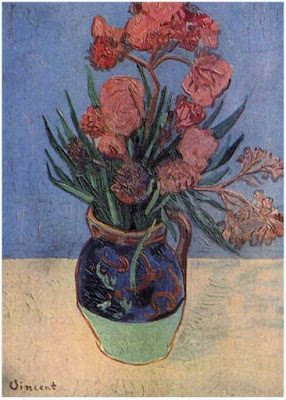Almost two years ago I did a post in this blog about the artist Louis Charles Moeller and the Art of Majolica. At the time I discussed the artist's use of the Wardle fan and bird pattern in his genre paintings. At the conclusion, I asked my readers to let me know if they were familiar with any other artists who used majolica in their work. Well, I never heard from anyone about it but I kept an eye open myself to try and locate similar situations. I never found any.
Earlier this year I did a post on the Choisy-le-Roi Aesthetic Series Plates. In that post I mentioned the strong influence of Japanese art on many Europeans including Vincent Van Gogh.
Have you ever heard the phrase "can't see the forest for the trees?" It is with great embarrassment that after two years I tell you of another artist who used majolica in his paintings—a very well known artist, in fact a great artist—and one whose work has become the very definition of impressionist art to many people: Vincent Van Gogh.
I was so embarrassed at discovering this, I even considered not sharing this information for the repercussions it might have to my reputation as a professional artist, but I thought about it and I realized that no one in the majolica community has ever made this connection before either, at least to my knowledge, so it may be of interest to my readers.
The work under discussion dates to one of the most creative and tumultuous periods in Van Gogh's life, the time he worked in the famous yellow house in Arles with Gauguin in late 1888. It was at this time that Van Gogh created some of his most iconic work including some of his early sunflower paintings. It was also during this time that part of his ear was cut off either by himself or in a fight with Gauguin.
Van Gogh did many a still life over the course of that year and many of them featured flowers, but sunflowers were not the only flowers he painted. He also did a series of drawings and paintings of wildflowers, Oleanders and many others. Besides flowers he also assembled groups of household objects for other still life subjects. It is here we find that many of these used a large majolica pitcher that we would recognize today: this Japanese influenced one, by Forester, with flying cranes on one side and prunus blossoms on the other.
Forester majolica crane pitcher
Forester majolica crane pitcher
Reverse of the Forester majolica crane pitcher
I'm not sure how many paintings and drawings he did featuring this pitcher but he certainly did a number of them, some with a number of variations among them.
One slightly odd thing becomes apparent in viewing the paintings as a group however. There are two color variations of the same jug shown in the paintings: cobalt ground with turquoise basket weave, and cobalt ground with yellow basket weave. Did he have two of the same pitcher or did he use his imagination in creating the color palette for the paintings? I favor the former conclusion because both color combinations are known to exist in this pattern.
Isn't this an interesting thought? Imagine, Vincent Van Gogh owning two examples of the same pitcher we know from our collections today! Perhaps one was his and one was used by Gauguin during the tempestuous time they lived together. All the art dates to the latter part of that very year so anything's possible!
I guess we'll never know for sure for all that survives is the art, but what a legacy of art this common majolica pattern leaves us!













No comments:
Post a Comment